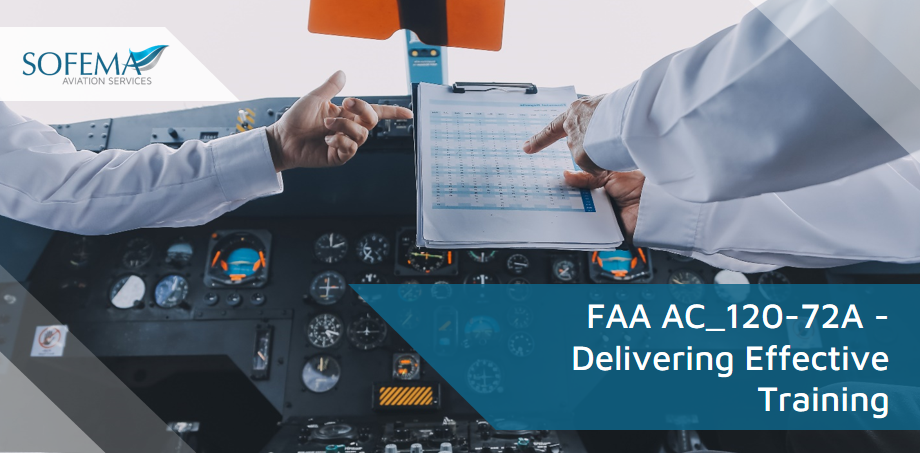Sofema Aviation Services (SAS) www.sassofia.com considers key features to effectively deliver FAA HF Training compliant with FAA AC_120-72A.
Introduction
A well-structured training program on AC 120-72A should cover the essential aspects of:
- Maintenance of Human Factors, focusing on understanding HF principles, identifying common errors,
- Promoting a safety culture,
- Enhancing communication,
- Implementing SMS,
- Managing fatigue, and
- Improving ergonomics.
Measuring the training’s success through:
- Assessments,
- Feedback,
- Observation, and
- Follow-up
Training Objectives
- Understand Human Factors (HF): Participants should understand human factors and their impact on aviation maintenance.
- Identify the Dirty Dozen: Recognize the twelve common maintenance-related causes of errors.
- Promote Safety Culture: Foster an organizational culture prioritizing safety.
- Enhance Communication Skills: Improve team communication to prevent misunderstandings and errors.
- Implement Safety Management Systems (SMS): Understand the role and implementation of SMS in aviation maintenance.
- Recognize and Mitigate Fatigue: Learn about fatigue and methods to manage it.
- Apply Ergonomic Principles: Understand and apply ergonomics to improve work conditions and safety.
Example Training Program Structure
Introduction to Human Factors (HF)
- Definition and importance of HF in aviation maintenance.
- Historical background and evolution of HF in aviation.
- Key concepts: Active Failure, PEAR (People, Environment, Actions, Resources).
The Dirty Dozen
Detailed overview of the twelve most common maintenance errors.
- Case studies and real-life examples of errors and their consequences.
- Group discussion on personal experiences and identification of these errors in participants’ work environments.
Safety Culture and Organizational Factors
- Definition and components of a safety culture.
- The role of organizational factors in promoting safety.
- Strategies for fostering a positive safety culture.
Communication at Work
Importance of effective communication in maintenance operations.
- Techniques to improve communication and reduce errors
- .Role-playing exercises to practice communication skills.
Safety Management Systems (SMS)
- Overview of SMS and its components.
- Implementation strategies for SMS in maintenance organizations.
- Case studies highlighting successful SMS implementations.
Fatigue Management
Understanding fatigue and its impact on performance.
- Strategies to manage and mitigate fatigue.
- Group discussion on personal experiences and best practices.
Ergonomics in Maintenance
Introduction to ergonomics and its importance in the workplace.
- Practical tips to improve ergonomic conditions.
- Exercises to identify and rectify ergonomic issues.
Review and Evaluation
Review of key points covered throughout the day.
- Interactive discussion on the application of learned concepts.
- Distribution of feedback forms and discussion on continuous improvement.
Pre- and Post-Training Assessments:
Conduct assessments before and after the training to measure knowledge gains.
- Use quizzes, multiple-choice questions, and scenario-based questions.
Participant Feedback:
- Gather feedback through surveys to evaluate the training effectiveness and areas for improvement.
- Include questions on content relevance, delivery methods, and overall satisfaction.
Behavioural Observation:
- Observe participants during interactive sessions and role-plays to assess the practical application of concepts.
- Provide constructive feedback to improve skills.
Follow-Up:
- Schedule follow-up sessions or surveys to assess long-term retention and application of training concepts.
- Encourage participants to share success stories and challenges in applying what they learned.
To ensure the training’s success, it is crucial to measure its effectiveness through pre- and post-training assessments, gather participant feedback, conduct behavioural observations, and implement follow-up sessions. These methods will help evaluate knowledge gains, training relevance, practical application of concepts, and long-term retention.
By focusing on these key aspects and continuously improving the training based on feedback and observations, organizations can significantly reduce maintenance errors, enhance safety culture, and improve overall operational efficiency in aviation maintenance.
Next Steps
Follow this link to our Library to find & download related documents for Free.
Sofema Aviation Services (www.sassofia.com) and Sofema Online (www.sofemaonline.com) provide Training for Trainers to support organisations wishing to develop EASA-compliant internal Part 145 Initial and Recurrent Training. Please see the websites or email team@sassofia.com
Tags:
aviation, aviation safety, Human Factors, Safety Assessments, Training, FAA, SAS blogs, Fatigue Management, Airport Safety, communication, Ergonomics, Effective SMS, AC_120-72A




